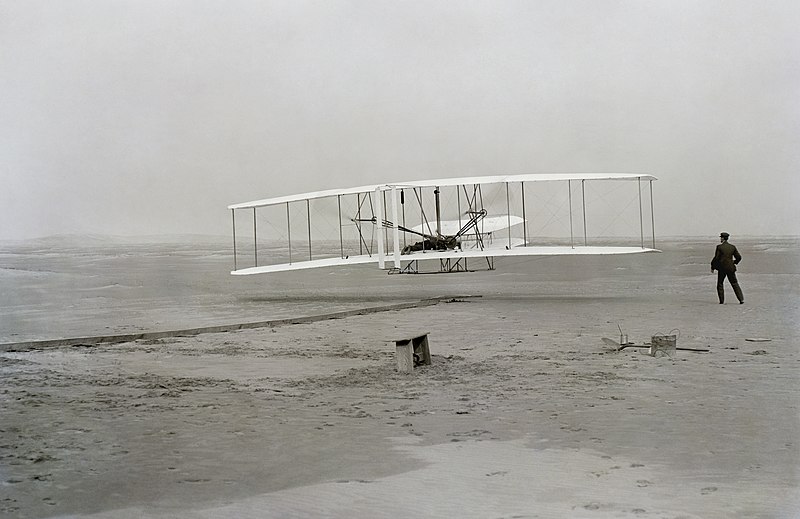There are early legends of human flight such as the story of Icarus in Greek myth and Jamshid in Persian myth, and later, somewhat more credible claims of short-distance human flights appear, such as the flying automaton of Archytas of Tarentum (428–347 BC),[2] the winged flights of Abbas Ibn Firnas (810–887), Eilmer of Malmesbury (11th century), and the hot-air Passarola of Bartholomeu Lourenço de Gusmão (1685–1724).
The modern age of aviation began with the first untethered human lighter-than-air flight on November 21, 1783 of a hot air balloondesigned by the Montgolfier brothers. The practicality of balloons was limited because they could only travel downwind. It was immediately recognized that a steerable, or dirigible, balloon was required. Jean-Pierre Blanchard flew the first human-powered dirigible in 1784 and crossed the English Channel in one in 1785.
There are many competing claims for the earliest powered, heavier-than-air flight. The first recorded powered flight was carried out byClément Ader on October 9, 1890 when he reportedly made the first manned, powered, heavier-than-air flight of a significant distance (50 m (160 ft)) but insignificant altitude from level ground in his bat-winged, fully self-propelled fixed-wing aircraft, the Ader Éole.[6][7][8]Seven years later, on 14 October 1897, Ader's Avion III was tested without success in front of two officials from the French War ministry. The report on the trials was not publicized until 1910, as they had been a military secret. In November 1906 Ader claimed to have made a successful flight on 14 October 1897, achieving an "uninterrupted flight" of around 300 metres (985 ft) on . Although widely believed at the time, these claims were later discredited
However, the most widely accepted date is December 17, 1903 by the Wright brothers. The Wright brothers were the first to fly in a powered and controlled aircraft. Previous flights were gliders (control but no power) or free flight (power but no control), but the Wright brothers combined both, setting the new standard in aviation records. Following this, the widespread adoption of ailerons rather than wing warping made aircraft much easier to control, and only a decade later, at the start of World War I, heavier-than-air powered aircraft had become practical for reconnaissance, artillery spotting, and even attacks against ground positions.
source : wikipedia

source : wikipedia
The modern age of aviation began with the first untethered human lighter-than-air flight on November 21, 1783 of a hot air balloondesigned by the Montgolfier brothers. The practicality of balloons was limited because they could only travel downwind. It was immediately recognized that a steerable, or dirigible, balloon was required. Jean-Pierre Blanchard flew the first human-powered dirigible in 1784 and crossed the English Channel in one in 1785.
There are many competing claims for the earliest powered, heavier-than-air flight. The first recorded powered flight was carried out byClément Ader on October 9, 1890 when he reportedly made the first manned, powered, heavier-than-air flight of a significant distance (50 m (160 ft)) but insignificant altitude from level ground in his bat-winged, fully self-propelled fixed-wing aircraft, the Ader Éole.[6][7][8]Seven years later, on 14 October 1897, Ader's Avion III was tested without success in front of two officials from the French War ministry. The report on the trials was not publicized until 1910, as they had been a military secret. In November 1906 Ader claimed to have made a successful flight on 14 October 1897, achieving an "uninterrupted flight" of around 300 metres (985 ft) on . Although widely believed at the time, these claims were later discredited
However, the most widely accepted date is December 17, 1903 by the Wright brothers. The Wright brothers were the first to fly in a powered and controlled aircraft. Previous flights were gliders (control but no power) or free flight (power but no control), but the Wright brothers combined both, setting the new standard in aviation records. Following this, the widespread adoption of ailerons rather than wing warping made aircraft much easier to control, and only a decade later, at the start of World War I, heavier-than-air powered aircraft had become practical for reconnaissance, artillery spotting, and even attacks against ground positions.
source : wikipedia

source : wikipedia


0 Comments:
Enregistrer un commentaire